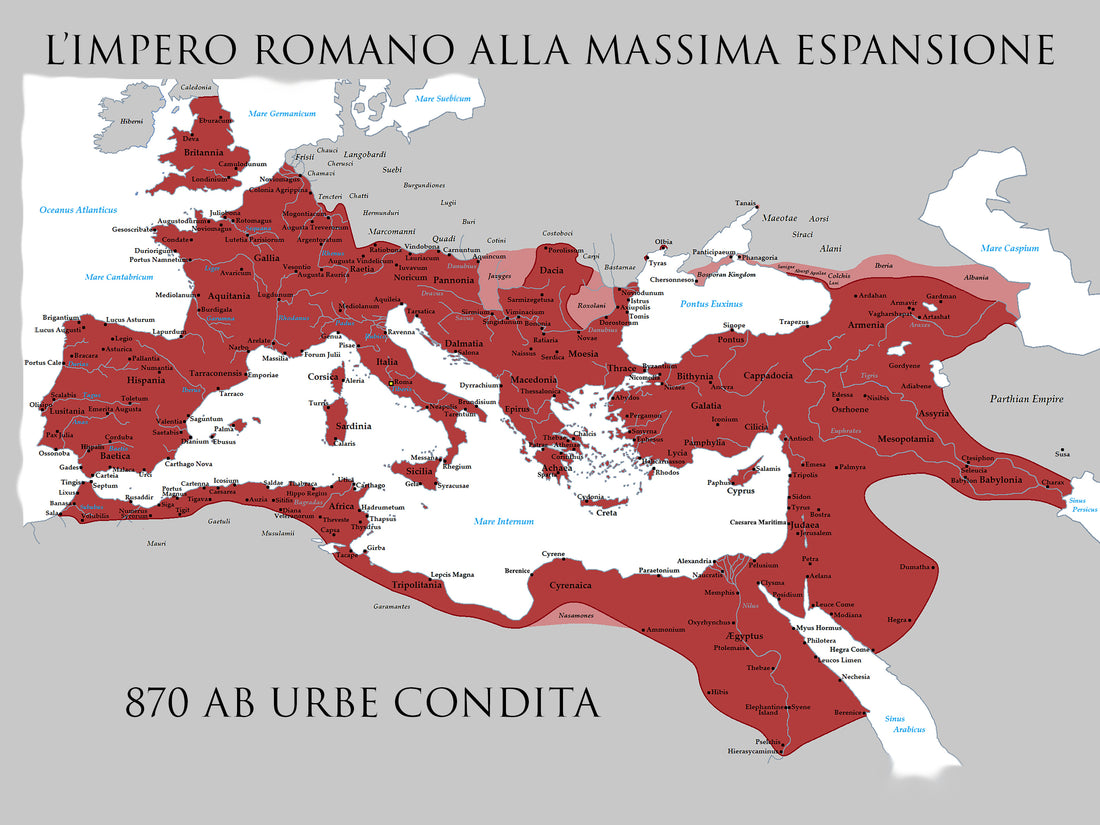
Trajan and the Maximum Expansion of the Roman Empire
Alice PettirossoShare
Trajan's Universal Ambition: The Meeting with the Indian Ambassadors
In 117 AD, under the leadership of the ambitious emperor Trajan , the Roman Empire reached its greatest expansion , dominating territories ranging from the British Isles to the borders of Mesopotamia. It was a period of extraordinary prosperity and grandeur, with Rome not only consolidating its power in the West, but also aiming ever higher, turning its gaze towards the East. Trajan , among the most famous emperors in Roman history, not only led victorious military campaigns against the Parthians, but established control over key territories such as Armenia and Mesopotamia, earning him the honorific title of Parthicus.
Trajan's Conquests: The Expansion Towards the East
The campaign against the Parthians, begun in 113 AD, had a clear goal: to reassert Rome's influence in the East and punish the Parthians for imposing their own candidate on the throne of Armenia, long considered a vassal kingdom of Rome. Trajan , with his extraordinary military genius, achieved significant victories, managing to conquer the Parthian capital, Ctesiphon, in 116 AD, and to create new Roman provinces, including Armenia, Mesopotamia, and Assyria. However, these lands, although conquered by force, proved difficult to govern, despite the emperor's iron determination.
Meeting with Indian Ambassadors: Between Myth and Reality
Among the lesser-known but highly symbolic events of this period is the alleged meeting between Trajan and an Indian embassy. Although Roman sources do not provide direct evidence of the meeting, we know that contacts between Rome and India were certainly not rare. Already at the time of Augustus, as Pliny the Elder and Strabo recall, Indian embassies had arrived in Rome, attracted by the power and magnificence of the Empire, with the intent of establishing stronger commercial ties.
The echo of the alleged embassy during Trajan 's eastern campaign could be seen as a reflection of the network of trade that crossed the Red Sea and the Indian Ocean, uniting Rome and the East. Rome imported spices, silk, ivory and precious stones from India, while exporting wine, glass and metals, in a cycle of exchange that enriched both civilizations.
Exotic Gifts: A Tiger for Rome?
According to some sources, one of the most unusual gifts that the Indian ambassadors brought to Trajan was a "tiger cub". Although this detail is not confirmed by direct historical sources, the idea of exotic animals as gifts from ambassadors is not far-fetched. Tigers, elephants and lions, coming from distant lands, were often exhibited in the grandiose shows of the Roman amphitheatre, where they animated the famous venationes, the hunts with wild animals.
ORDER YOUR REPRODUCTION AT HOME
Trajan , with his obvious taste for luxury and the allure of the exotic, would undoubtedly have been impressed by such a gift. During the celebrations after the victory over the Dacians, in fact, he organized extraordinary games that included fights with wild animals imported from remote regions, offering the Roman people a taste of the unknown and mysterious world beyond the imperial borders.
Trajan and the Dream of Alexander the Great
Perhaps Trajan had the ambition to emulate Alexander the Great, the most illustrious conqueror of antiquity. This was an aspiration shared by many Roman emperors, and Trajan was no exception. Although there is no concrete evidence of a detailed plan to advance to India, the idea that he wanted to push towards the extreme limits of the known world is likely.
A famous inscription found at Seleucia, along the Tigris, celebrates his victories over the Parthians and hints at the possibility of further advances. But logistical and political challenges, as well as the fragile stability of his new conquests, made it impossible for Trajan to carry out his grandiose dream of expansion.
The Death of Trajan and the Legacy of an Unfulfilled Dream
Trajan died in 117 AD, while returning to Rome, probably due to illness, without having definitively consolidated the eastern conquests. His successor, Hadrian, chose to abandon much of those territories to devote himself to the stabilization of the imperial borders, marking the end of the expansion to the East. Yet, the dream of a Rome that looked to the East did not vanish with him. Throughout the imperial period, Rome maintained a strong interest in those distant lands, not only for commercial reasons, but also for the cultural and intellectual influence they exerted.
The meeting with the Indian ambassadors, whether real or symbolic, represents an episode that perfectly embodies the image of Rome as the center of the ancient world, recognized and respected even by civilizations as far away as India. The event, true or legendary, reflects the profound fascination that the East exerted on the Roman imagination: a land of wonders, riches and endless promises.
The Enduring Allure of the Orient
The ties between Rome and the East continued to flourish in the following centuries, especially under the Byzantine Empire, which considered itself the direct heir of Rome. Trade and diplomatic missions with India and other eastern regions continued, fueled not only by economic interests, but also by cultural and intellectual curiosity. The Romans, and then the Byzantines, were fascinated by the knowledge and products that came from those distant lands, as demonstrated by the numerous tales of merchants and travellers.

